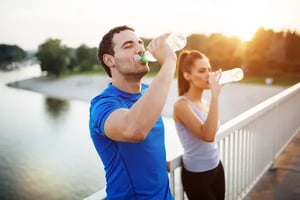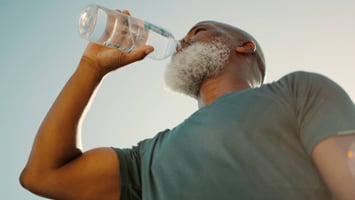Hydrate to Dominate: Why Hydration is Essential for Peak Performance
Wilmington Runners: Beat the Heat and Conquer Your Summer Runs (An In-Depth Guide)
Hey Wilmington runners! We see your dedication, pounding the pavement through sunshine and rain. But with these scorching temperatures and humidity warnings plaguing our beautiful coastal city, it's critical to adjust your routine to stay safe and optimize your summer runs. Here at Conquer Movement PT, we're passionate about helping Wilmington athletes achieve their goals, and that includes conquering the heat!
This comprehensive guide will equip you with the knowledge and strategies to dominate your summer runs while prioritizing safety and performance.
The Wilmington Heat Challenge: Understanding the Enemy
Wilmington boasts a humid subtropical climate, meaning summers are notoriously hot and sticky. Humidity plays a significant role in how our bodies manage heat. When sweat evaporates from our skin, it cools us down. However, high humidity reduces evaporation efficiency, making it harder to regulate body temperature. This creates a perfect storm for heat-related illnesses like heatstroke, dehydration, and decreased performance.
Early Bird Gets the Worm (and avoids the heat stroke):
Sun's out, guns out? Not quite for summer runners in Wilmington. Aim for the cooler mornings, ideally before sunrise. This gives your body a crucial advantage:
- Lower Ambient Temperature: Early mornings offer significantly lower temperatures, reducing stress on your body's thermoregulation system. Running becomes a more enjoyable and efficient experience.
- Reduced Sun Exposure: The sun is less intense in the early hours, minimizing the risk of sunburn and heatstroke.

Hydration: The Unsung Hero of Summer Running
Hydration isn't just about chugging a bottle of water before you head out. It's a continuous process that requires strategic planning and execution. Here's how to become a hydration master:
- Pre-Run: Aim for 16-20 ounces of water 2-3 hours before your run. This allows your body to absorb the water and distribute it throughout your system.
- During Your Run: Don't wait until you're thirsty! Thirst is a sign you're already dehydrated. Take small sips every 15-20 minutes, even if you feel fine. Consider a hydration pack or carrying a handheld water bottle for convenient access.
- Post-Run: Don't wait until you're parched! Aim to replace fluids lost during your run. Weigh yourself before and after your run. A good rule of thumb is to drink 16 ounces of water for every pound lost.
Electrolytes: Your Body's Power Source
Sweat doesn't just contain water, it also carries electrolytes – essential minerals like sodium, potassium, and magnesium. These minerals play a crucial role in muscle function, nerve transmission, and maintaining proper hydration levels. When you sweat, you lose electrolytes, which can lead to:
- Muscle cramps
- Fatigue
- Dizziness
- Nausea
Electrolyte Replenishment Strategies:
There are several ways to replenish electrolytes lost through sweat:
- Sports Drinks: Formulated with electrolytes and carbohydrates, sports drinks can be a convenient way to replace fluids and electrolytes during longer runs. Choose options with moderate sugar content and avoid sugary sports drinks marketed for post-workout recovery.
- Electrolyte Packets: These packets, from brands such as LMNT or liquid I.V. dissolve in water, allowing you to customize the concentration of electrolytes in your drink. Ideal for runners who find sports drinks too sweet and also a healthier option with less chemicals, artificial sweeteners, and dyes.
- Coconut Water: A natural source of electrolytes, particularly potassium and magnesium. However, coconut water is low in sodium and should be combined with other electrolyte sources for longer runs.
Fueling Your Run: The Right Food at the Right Time
Food plays a vital role in summer running performance. Here's what to consider:
- Pre-Run Meal: Aim for a balanced meal rich in complex carbohydrates and protein 2-3 hours before your run. This provides sustained energy for your run. Examples include oatmeal with berries and nuts, whole-wheat toast with peanut butter and banana, or a yogurt parfait with granola and fruit.
- Mid-Run Fueling: During longer runs (over 60 minutes), consider consuming energy gels, chews, or bars. Look for options with easily digestible carbohydrates like dextrose or maltodextrin.
- Post-Run Recovery: Replenish your glycogen stores and repair muscle tissue with a balanced meal or snack high in carbohydrates and protein within 30 minutes of finishing your run. Examples include a chicken breast with brown rice and vegetables, a protein smoothie with fruit and spinach, or whole-wheat pasta with lean ground turkey and marinara sauce.
Beat the Heat with Cooling Strategies
Here are some practical tips to manage your body temperature during your run:

- Clothing: Your Body's Cooling System on the Move
Gone are the days of cotton t-shirts for summer runs. Your clothing choices play a significant role in managing your body temperature and optimizing performance. Here's what to look for in your summer running wardrobe:
-
Fabric Matters: Opt for lightweight, loose-fitting, moisture-wicking fabrics. These fabrics draw sweat away from your skin, promoting evaporation and keeping you cool. Look for materials like:
- Polyester: A synthetic fabric that wicks moisture efficiently and dries quickly.
- Nylon: Another synthetic option known for its durability and moisture-wicking properties.
- Blended Fabrics: Many running shirts and shorts combine polyester and nylon for optimal comfort and performance.
- Merino Wool: While wool might seem counterintuitive for hot weather, merino wool is a fantastic option for runners who tend to get chills after sweating. Merino wool is naturally moisture-wicking, odor-resistant, and surprisingly breathable.
-
Color Coordination: Lighter colors like white, light gray, or pastel shades reflect sunlight, helping to keep you cooler. Avoid dark colors that absorb heat.
-
Fit for Function: Loose-fitting clothing allows for better air circulation around your body, promoting sweat evaporation. However, avoid clothes that are too baggy, as they can chafe during your run, leading to a whole host of other problems.
Cooling Accessories:
- Visor or Hat: Protect your head and face from the sun's harsh rays. Choose a light-colored, breathable hat or visor. Some options come with built-in sweatbands to keep sweat out of your eyes.
- Sunglasses: Invest in a good pair of sunglasses with UV protection to shield your eyes from the sun and reduce glare.
- Cooling Sleeves or vests: These innovative garments utilize special fabrics or technologies to help keep you cool. Cooling sleeves can be worn on your arms for targeted cooling, while cooling vests provide a more comprehensive cooling effect. If you don't want to make a fashion statement then something as symbol as a cooling towel around the neck while running can help.
Knowing When to Say No: Postponing Your Run for Safety
While dedication is admirable, sometimes the heat wins. Here are some signs you should consider postponing your run:
-1.jpeg?width=225&height=225&name=download%20(3)-1.jpeg)
- Heat Advisories and Warnings: Pay attention to weather advisories issued by local authorities. If a heat advisory or warning is in effect, it's best to err on the side of caution and reschedule your run.
- Feeling Overheated Before You Start: If you're feeling hot and sweaty even before stepping outside, it's a sign your body may already be struggling to regulate its temperature. Consider a shorter, cooler run later in the day or opt for a different activity altogether.
- Chronic Health Conditions: Certain health conditions, such as heart disease, diabetes, and high blood pressure, put you at a higher risk of heat-related illnesses. If you have any concerns, consult with your doctor before running in hot weather.
Alternative Activities for Hot Days:
Don't let the heat sideline your fitness goals! Here are some alternative activities you can enjoy on scorching days:
- Swim: Take advantage of Wilmington's beautiful beaches or pools and enjoy a refreshing swim.
- Yoga or Pilates: These activities offer a great workout without the heat stress. Many studios offer virtual classes, allowing you to exercise from the comfort of your air-conditioned home.
- Strength Training: Hit the gym for a strength-training session. Focus on exercises that don't require heavy breathing, such as bodyweight exercises or machine-based workouts.
Heatstroke: Recognizing the Danger Zone
Heatstroke is a life-threatening medical emergency that occurs when your body can no longer regulate its core temperature. It's crucial to be aware of the warning signs and take immediate action if you suspect someone is experiencing heatstroke.
Here's what to watch out for:
- High Body Temperature: The most defining symptom of heatstroke is a body temperature of 104°F (40°C).
- Mental Confusion: Altered mental state is a hallmark sign. This can manifest as confusion, disorientation, slurred speech, seizures, or even coma.
- Skin: Heatstroke can present with either dry, hot skin (often a sign of classic exertional heatstroke) or moist, pale, and clammy skin (more common in non-exertional heatstroke).
- Nausea and Vomiting: Feeling nauseous or vomiting are common symptoms of heatstroke.
- Headache: A throbbing headache is a frequent indicator of heatstroke.
- Dizziness or Fainting: Feeling dizzy or lightheaded, or even fainting, can occur with heatstroke.
- Rapid, Weak Pulse: Your pulse may become rapid and weak as your body struggles to cope with the heat.
Who is Most Susceptible to Heatstroke?
While anyone can experience heatstroke, certain factors increase your risk:
- Infants and Young Children: Their bodies are less efficient at regulating temperature.
- Older Adults: Their thermoregulatory systems may be less effective, and they may be more prone to dehydration.
- People with Chronic Health Conditions: Conditions like heart disease, diabetes, and high blood pressure can increase the risk of heatstroke.
- People Taking Certain Medications: Medications that affect sweating or hydration can make you more susceptible to heatstroke.
- People Who are Overweight or Obese: They may have more difficulty regulating body temperature.
- People Not Accustomed to Hot Weather: Those who haven't acclimatized to hot and humid conditions are at higher risk.
Remember: If you suspect someone is experiencing heatstroke, call 911 immediately. Don't wait for symptoms to worsen. Early intervention is crucial for preventing serious complications or even death.
Disclaimer: This blog post is for informational purposes only and is not a substitute for professional medical advice. Always consult with a healthcare professional before starting a new exercise program, especially if you have any pre-existing medical conditions.
By following these tips and making smart choices, you can conquer the Wilmington heat and keep your summer runs safe, enjoyable, and productive. Remember, prioritizing your health and well-being is the name of the game. Listen to your body, adjust your routine when necessary, and keep crushing your running goals throughout the summer!
Stuck in a running rut? Conquer Movement PT's expert sports docs can help you smash through limitations and reach your full running potential! Book a FREE consultation call with our experts and take the first step to pain free running!






Leave A Comment: